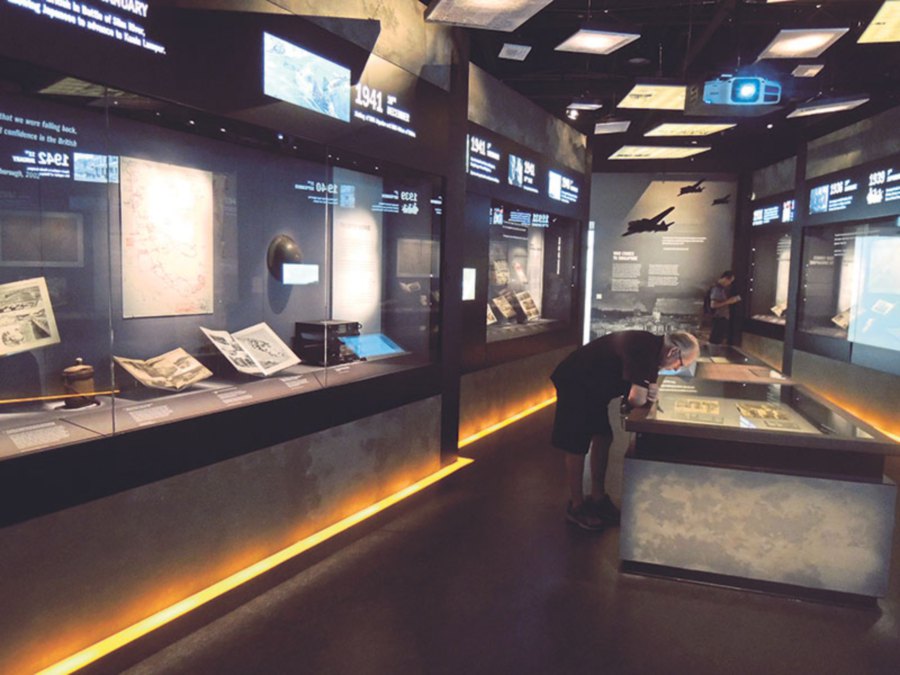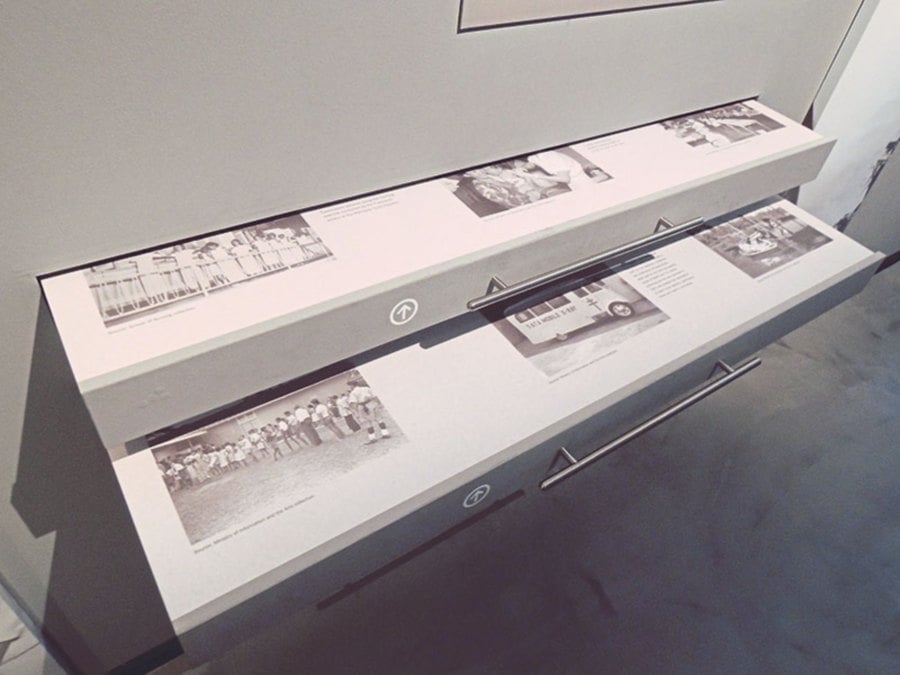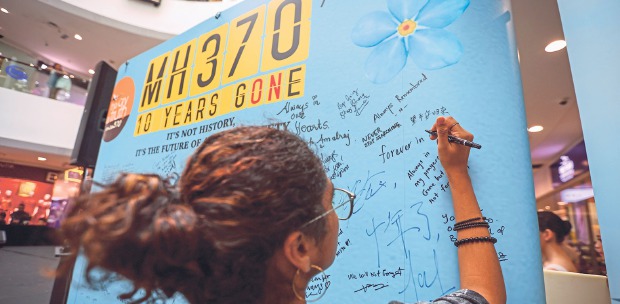The low drone of the high altitude aircraft at around midnight catches Mustafa Hussain by surprise. Its persistent hum is definitely different from those made by Japanese fighter planes in flight. It has already been four years since Singapore and all of Malaya were occupied and he, just like many others in Singapore, has become accustomed to the familiar sounds of the Japanese aeroplanes. Intrigued, Mustafa snuffs out the lights in his wooden house and rushes out barefoot.
Out in the open, the sounds grow considerably louder. Judging from the increasingly audible clarity, Mustafa realises that the aircraft is heading towards his area in Katong. Looking up, he quickly scans the moonless August night hoping for a glimpse of the plane. But his hopes are dashed. Just minutes later, the sound eventually dissolves into the night.
Then, just as he’s about to go back indoors, a soft rustle above his head makes him look up once again. He’s just in time to see multiple pieces of white-coloured paper raining down around him. He quickly catches one in mid-air.
The words are difficult to read in the darkness but Mustafa, who works at the Fujiwara Kikan office at Farrer Road, can roughly make out the British coat of arms near the upper edge. He soon realises that the paper in his hand is a message from the Allied forces to the people of Singapore. The British Royal Air Force must have taken advantage of the pitch-dark night to clandestinely pepper the island with these leaflets.
Alarm bells immediately start ringing in Mustafa’s head. The dreaded Japanese secret police or Kempetai will surely go after those with this paper in their possession. Keeping this paper is like signing one’s death warrant!
Suppressing his desire to read the content, Mustafa swiftly gathers all the papers within sight; his plan is to burn every single piece later. Before going indoors, he takes a peek down Amber Road and sees more leaflets strewn all over the place. “Never mind, my neighbours will surely destroy them when they wake up tomorrow,” he tells himself before returning indoors and bolting the main door securely behind him.

De-ja vu
It’s already past 10am when my taxi veers off Bukit Timah Road and rumbles slowly along a narrow side road towards a large single storey building. In the distance, I see my friend and Singapore history buff Dan Teo already waiting for me.
The moment I alight, Teo places a clear plastic folder into my hands before excitedly telling me that it contains an important historical item related to the Japanese Occupation. We head over to a nearby bench by the porch to discuss his latest acquisition.
“This leaflet advising the people to begin preparing for the British return was air-dropped all over Singapore and Malaya about three weeks after atomic bombs detonated in Hiroshima on Aug 6, 1945 and Nagasaki three days later,” begins Teo. “Japan was brought to its knees as a result of the devastation suffered by its citizens in both these major cities.”
Scrutinising the paper, which is now slightly yellow with age, I note that it’s just like the ones found by Mustafa during the dying days of the Japanese Occupation. This leaflet also has the British lion and unicorn crest.
The message on the parchment, points out Teo, is printed in the four main languages in order to reach all segments of society. “Basically the message tells people not to fear the British when they return and assures them that only those found guilty of causing grievous harm to the British and other Allied subjects would be punished,” he elaborates.
The contents allow me to understand the reasons why people like Mustafa chose to quickly dispose of the papers, which they found on the fateful day of Aug 28, 1945. This copy in Teo’s hand has many visible creases, which indicate to me that the previous owner must have folded this parchment into a very small size and hid it in a very secure place, away from the Kempetai and its spies.
Noticing my growing interest in the Japanese Occupation, Teo invites me into the building, which once served as the former Ford Motor factory in Singapore prior to the Second World War. Recently refurbished, it’s now home to a permanent display called Surviving the Japanese Occupation: War and its Legacies, and is managed by the National Archives of Singapore.
A surreal experience
The informative galleries tell a grim tale of human hardship and sacrifices. I particularly like the sections that allow me to listen to audio recordings of people who’d lived through the period. Hearing their first hand narrations certainly feels surreal. At times, I find myself unintentionally gripping the headphones tightly especially when the tales involve torture and sufferings beyond those of human imagination.
The Kempetai had vast powers to maintain law and order in Singapore. This military police force had a vast network of spies and informers at its disposal. This feared network was regularly used to ferret out those who were suspected to be anti-Japanese. These spies and informers who formed part of the local community wielded great powers. A report from any one of them would surely land people in trouble and render their families destitute.
This Kempetai technique of intelligence-gathering generated a horrible atmosphere of constant fear and suspicion within each community.
Raids were often conducted during the wee hours of the morning when the suspects were most likely to be in bed. Those apprehended were not allowed to change and were taken away in their pyjamas. At the Kempetai headquarters in Orchard Road, both males and females were placed together in a small holding cell, which had only one toilet.
The suspects had to remain in a kneeling position throughout the entire interrogation process. Bamboo canes were administered liberally when answers weren’t given fast enough. Those who failed to confess after the severe beatings would be subjected to other more severe forms of torture.
I cringe in fear looking at the various photographs and caricatures on display showing the more “advanced” forms of inflicting misery. These range from electric shock treatments to using pliers to rip out finger and toe nails. It must have been excruciating to have thin bamboo slivers inserted into the raw nail beds.
The most dreaded form of torture was the water treatment, which involved tying the prisoner and putting him flat on the ground, facing upwards. Then, copious amounts of water were forced into his mouth and nose until he lost consciousness. After that, the captors would force the water out by jumping on their prisoner’s abdomen. The prisoner would subsequently be revived for the process to be repeated again. This heartless act would continue until a confession of guilt was obtained — or death occurred.
Prisoners weren’t the only ones who suffered during the Japanese Occupation. The entire economy was in shambles and inflation sky rocketed. In the midst of severe food shortages and broken supply chains, the general public often had to turn to the black market for their basic necessities.

Tortured existence
The main venue for such goods was the Sungei Road flea market, (which was closed recently to make way for a spanking new MRT station that bears its name). During the war years, it was often referred to as Robinson Petang because business only started in the afternoon and the variety of goods available reminded the people of the large departmental store in Raffles Place that was shuttered after it was hit by bombs twice during the Japanese invasion.
There, beside the banks of the Rochor River, black marketers sat by their roadside stalls and displayed small sample of goods. Most of these items, especially cigarettes and condensed milk, were said to have been looted during the turbulent transition period when power shifted from the surrendering British to the victorious Yamashita-led Japanese army.
Food shortage finally reached tipping point in the middle of 1943. To help reduce demand for food, the Japanese government sought 300,000 people to voluntarily move out of Singapore and set up food farms in Negri Sembilan and Johor. The administrators gave the people an incentive to leave by pledging that no Japanese would be allowed into the new settlements. With that promise, the quota was filled in no time at all.
I’m filled with sadness listening to the narration from one of the settlement pioneers by the name of Chu Sien Choo. “I burst into tears after reaching Endau. We were promised a proper house but there waiting for us were only barracks in the form of covered wooden platforms with walls of dried leaves. On top of that, many of us who’d been living in the city all our lives didn’t have any knowledge of farming at all,” she recalls. Chu had made the arduous journey with her husband. She also talked about dreading leeches during her daily sojourns at the paddy fields. “Many of us hoped and prayed that the British would soon return and liberate us from all this hardship.”
Finally, Teo and I arrive at the section, which highlights the last days of the Occupation. There are more leaflets here announcing the downfall of the Japanese. Although the leaflets look different from the one Teo showed me earlier, they nonetheless shared the same message: the promise of better days ahead.
It has been 72 years to this day when the crew of Enola Gay dropped the world’s first atomic bomb on a populated city. The Hiroshima bomb was nicknamed Little Boy but it did widespread damage the moment it hit the ground at about 8.30 am, exactly at a time when the people were getting ready to face a new day. Many lives were lost on that fateful day. It’s sad that the bombs had to be used in order to herald the beginning of the end of the worst war in living memory.










